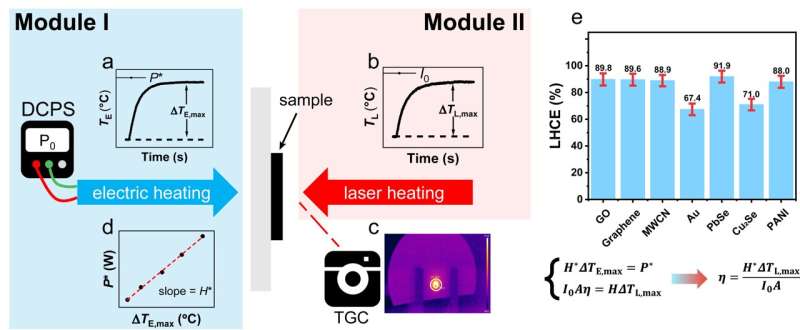A general methodology to measure the light-to-heat conversion efficiency of solid materials

Light-to-heat conversion has been intensively investigated due to the potential applications including photothermal therapy and solar energy harvesting. Light-to-heat conversion efficiency (LHCE) is the most important figure of merit for evaluating photothermal materials, such as organic molecules, carbon-based materials and nanocrystals.
Based on the heat balance equation, a few methodologies have been successfully developed to measure LHCE of colloidal nanocrystal solution. Although these methods have been further improved by other researchers, their accuracy is still in debate due to overestimation of the mass term of measurement system as well as the imprecise fitting of heat dissipation coefficient. In addition, most of the reported methodologies are limited to colloidal solutions.
In a new paper published in Light: Science & Applications, Kai Gu and Haizheng Zhong from Beijing Institute of Technology have developed a general methodology to measure the LHCE of solid materials. They propose a photothermal and electrothermal equivalence (PEE) method that simulates the laser heating process with electric heating process.
In electrothermal measurement, the heat dissipation coefficient of the sample can be derived under a known electric power by performing a linear fitting at thermal equilibrium. In photothermal measurement, the maximum temperature change of the sample is monitored under laser heating to calculate the LHCE. In this study, the researchers investigate the versatility of the PEE method for various organic and inorganic photothermal materials, including Au nanorods, graphene and PbSe nanocrystals, among others.
Furthermore, the researchers discuss the error and reliability of the PEE method and deviations from assumptions to demonstrate the advantages of the PEE method.
The PEE method consists of two steps: electrothermal measurement (Module I) and photothermal measurement (Module II). Electrothermal measurement within the study was accomplished by determining the temperature increase of the sample on a resistor using a thermographic camera (TGC). Similarly, photothermal measurement was accomplished by determining temperature increase of the sample under laser heating.
By plotting the curve of temperature evolution versus time, the maximum temperature change can be obtained by monitoring the average temperature using TGC. Heat dissipation coefficient of the sample can be derived by linearly fitting the plots of the maximum temperature change and the input power of electric heating.
With the considerations of light absorbance and heat dissipation coefficient, the LHCE of the sample can be derived from the heat balance equation. To demonstrate the applicability of the PEE method, the researchers measured the LHCE of Au nanorods, PbSe nanocrystals, Cu2Se nanocrystals, multi-walled carbon nanotube (MWCN), graphene oxide (GO), graphene and polyaniline (PANI). Details of the error and assumption analysis can be found in the paper.
The research team has developed a robust and reliable method to measure the LHCE of solid materials, which has the potential to promote the fundamental research of advanced photothermal materials.
More information:
Kai Gu et al, A general methodology to measure the light-to-heat conversion efficiency of solid materials, Light: Science & Applications (2023). DOI: 10.1038/s41377-023-01167-6
Citation:
A general methodology to measure the light-to-heat conversion efficiency of solid materials (2023, July 24)
retrieved 24 July 2023
from https://phys.org/news/2023-07-general-methodology-light-to-heat-conversion-efficiency.html
This document is subject to copyright. Apart from any fair dealing for the purpose of private study or research, no
part may be reproduced without the written permission. The content is provided for information purposes only.
For all the latest Science News Click Here
For the latest news and updates, follow us on Google News.

